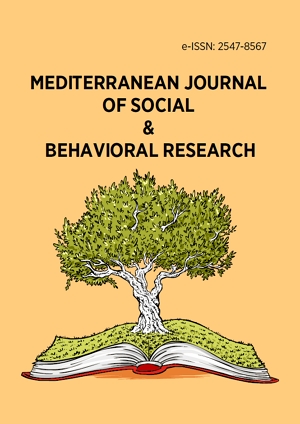Research Article
The Expectations and Reality of E-Learning
More Detail
1 Ilam University, Ilam, IRAN* Corresponding Author
Mediterranean Journal of Social & Behavioral Research, 6(2), June 2022, 61-66, https://doi.org/10.30935/mjosbr/11926
Submitted: 03 February 2022, Published: 25 March 2022
OPEN ACCESS 1506 Views 1120 Downloads
ABSTRACT
Following the historical and technological shifts that led to the wide emergence of transformative educational methods, this study offers a developmental perspective to the reality of E-learning. The study further discusses the development of E-learning applications and assess the availability and appropriateness of the educational curriculum and related pedagogical constructs in an Internet networked learning environment. In addition, there is an attempt to address the theoretical foundations of E-learning environments and the educational implications and affordance in the contexts of E-learning. The study, meanwhile, focuses on the effectiveness of E-learning, its advantages and disadvantages and explores how virtual learning is enhanced by merging its principles with the use of new technologies in education, how virtual learning may be improved by integrating educational principles with the use of modern technologies in the classroom, and how modern social practices influence the roles of both instructors and students.
CITATION (APA)
Aliakbari, M., & Hassen, Q. K. (2022). The Expectations and Reality of E-Learning. Mediterranean Journal of Social & Behavioral Research, 6(2), 61-66. https://doi.org/10.30935/mjosbr/11926
REFERENCES
- Almaiah, M. A., Al-Khasawneh, A., & Althunibat, A. (2020). Exploring the critical challenges and factors influencing the E-learning system usage during COVID-19 pandemic. Education and Information Technologies, 25, 5261-5280. https://doi.org/10.1007/s10639-020-10219-y
- Crossley, S. A., & McNamara, D. S. (2017). Adaptive educational technologies for literacy instruction. Routledge. https://doi.org/10.4324/9781315647500
- Ghavifekr, S., & Wan Rosdy, W. A. (2015). Teaching and learning with technology: Effectiveness of ICT integration in schools. International Journal of Research in Education and Science, 1(2), 175-191. https://doi.org/10.21890/ijres.23596
- Guikema, J. P., & Williams, L. (Eds.) (2014). Digital literacies in foreign and second language education. CALICO.
- Jewitt, C. (2008). Multimodality and literacy in school classrooms. Review of Research in Education, 32, 241-267. https://doi.org/10.3102/0091732X07310586
- Khan, H. U. (2006). Role of computer-mediated communication in solving collaborative learning empowerment problems in higher education: A case study of Oman. Innovation in Teaching and Learning in Information and Computer Sciences, 5(4), 21-36. https://doi.org/10.11120/ital.2006.05040021
- Kong, S. C. (2019). Partnership among schools in e-Learning implementation: Implications on elements for sustainable development. Educational Technology & Society, 22(1), 28-43.
- Kratochvílová, H., & Kratochvíl, R. (Eds.) (2017). Proceedings of IAC 2017 in Vienna. Czech Institute of Academic Education z.s.
- Lecon, C., & Hermann, M. (2020). Learning for e-learning. In D. Nagamalai, & D. C. Wyld (Eds.), Proceedings of the 7th International Conference on Computer Science, Engineering and Information Technology (pp. 29-43). AIRCC Publishing Corporation. https://doi.org/10.5121/csit.2020.101103
- Lee, M. J. W., & McLoughlin, C. (2010). Web 2.0-based e-Learning: Applying social informatics for tertiary teaching. Information Science Reference.
- Mesfin, G., Ghinea, G., Grønli, T.-M., & Hwang, W.-Y. (2018). Enhanced agility of e-Learning adoption in high schools. Educational Technology & Society, 21(4), 157-170.
- OECD. (2005). E-learning in tertiary education: Where do we stand? OECD Publishing. https://doi.org/10.1787/9789264009219-en
- OECD. (2016). Innovating education and educating for innovation: The power of digital technologies and skills. OECD Publishing. https://doi.org/10.1787/9789264265097-en
- Rami, Z. A. L., & Al-Tameemi, O. A. (2021). Role of virtual reality technologies in Iraqi educational spaces. Turkish Journal of Computer and Mathematics Education, 12(6), 3887-3901.
- Roy, R., Potter, S., Yarrow, K., & Smith, M. (2005). Towards sustainable higher education: Environmental impacts of campusbased and distance higher education systems. The Design Innovation Group.
- Shatnawi, H. A. (2019). The impact of e-learning on the management of knowledge among faculty members in private Jordanian Universities. American Journal of Operations Management and Information Systems, 4(1), 39-47.
- Wang, M., Ran, W., Liao, J., & Yang, S. J. H. (2010). A performance-oriented approach to e-learning in the workplace. Educational Technology & Society, 13(4), 167-179.
- Wombacher, J. C. (2020). Distance learning in an extraordinary circumstance (COVID-19): An initial assessment of student experience and coping in a trinational study programme. https://www.researchgate.net/publication/340478629.
- Zakariah, Z., Alias, N., Abd Aziz, M. N., & Ismail, N. Z. (2011). Elearning awareness in a higher learning institution in Malaysia. Procedia-Social and Behavioral Sciences, 67, 621-625. https://doi.org/10.1016/j.sbspro.2012.11.36

 The articles published in this journal are licensed under the CC-BY Creative Commons Attribution International License.
The articles published in this journal are licensed under the CC-BY Creative Commons Attribution International License.